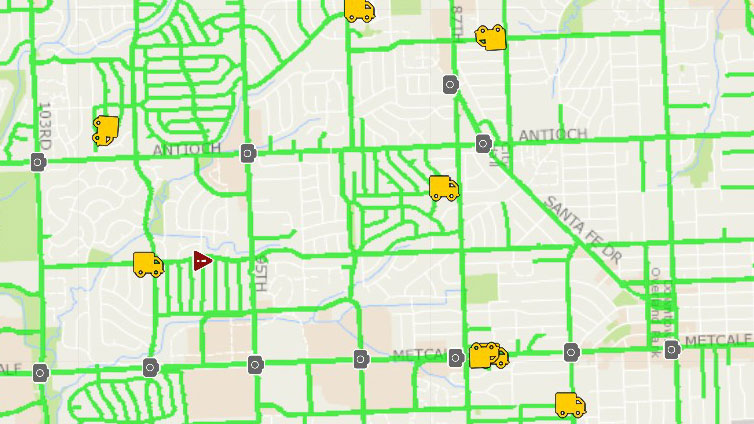Snow + Ice Removal
Snow + Ice Removal
The City’s Public Works Department follows a priority system for clearing snow and ice from more than 2,000 lane miles of streets and bridges. This includes:
- 2,021 cul-de-sacs
- 2,015 lane miles
- 59 bridge decks
More than 170 City employees from Public Works, Parks Services, Recreation Services, Planning, Police and Fire departments come together to respond in a weather event. Large dump truck and pickup-style plows, along with contracted large and pickup-style plows clear the streets.

Storm Operations Map
When snow crews are plowing or treating, use this map to view plow locations, live photos and videos of street conditions, and when your street was last treated or plowed.
Snow Removal Issues
Report and track a snow or ice removal issue directly online by submitting a ticket with OPCares, the city’s online customer service tool.
Before filing a request for a missed street, be sure you understand the priorities snow crews use when plowing and treating.
Snow Plow Damage
Report and track damage caused by a snow plow by submitting a ticket with OPCares, the city’s online customer service tool.
Minor Vehicle Accidents
Call 911 if you have an emergency.
During snow events, walk all minor crash reports in to the Overland Park Police Department within 72 hours. Minor crashes happen when
- no one is hurt
- the vehicles are driveable
- substance abuse is not a factor
- all parties remain at the scene
Drivers should exchange names, addresses, driver’s license and license plate numbers, and insurance information. Visit the W. Jack Sanders Justice Center or the Myron E. Scafe Building to file these reports.
Snow Removal Priorities
During a typical snow operation, the city’s streets are plowed by two crews working 12-hour shifts. Crews follow routes based on street priority.
Call 911 if there is a medical, fire or other public safety emergency. Police personnel will alert snow plow drivers and resources will be immediately dispatched to provide emergency service support.
Strategies can vary by storm, but typically snow crews plow and treat city streets in the following order:
Thoroughfares
High traffic volume multi-lane roads such as Metcalf Avenue, College Boulevard and Antioch Road are plowed continuously during snow operations.
Collectors
Two-lane streets that move traffic to a thoroughfare street are plowed from the start of snow operations until completed. Collectors typically border neighborhoods or commercial areas and include Lamar Avenue, 71st and 133rd streets. These are typically completed in the first 12-hour shift.
Residentials
Residential streets are plowed after snowfall stops and after other priority streets are treated and cleared.
Crews will apply materials to improve traction, but may not plow residential streets for ice or snowfall less than two inches. Plows will make a single pass around the perimeter of cul-de-sacs. When a large storm results in the buildup of snow and ice, crews will completely plow cul-de-sacs after all streets have been completed.
Help Snow Crews
Overland Park’s plow crews cover thousands of lane miles each storm. Residents and business owners can help by following the guidelines below.
While streets are being plowed or treated
- Do not park on the street until it has been plowed in order to leave a clear path for plow drivers
- Wait until plows have made at least one clear path before driving on a street
- Remove basketball goals, trash cans, and other obstacles from the curb or driveway entrances
After streets are plowed or treated, keep sidewalks free of ice and snow.
Plows typically leave a windrow of snow at the end of each driveway. It is each resident or business owner’s responsibility to shovel blocked driveways.
